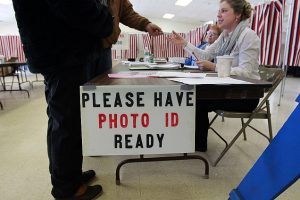Redistricting, Voter ID Laws, Early Voting, And The Post-Shelby World
Casting a ballot takes a lot of hard legal work.

(Photo by Suzanne Kreiter/The Boston Globe via Getty Images)
With the election right around the corner and the courts handing down a spate of critical rulings undermining years of alterations to electoral procedures pushed by local Republicans in the aftermath of Shelby County, we got an opportunity to sit down with some people on the front lines of the election law divide to take stock of where American democracy sits in 2016.
First, Ben Griffith of the Griffith Law Firm in Oxford, Mississippi and Robert Heath of Bickerstaff Heath Delgado Acosta discussed election law in the context of the new book America Votes (affiliate link), which Griffith also edited. In a wide-ranging discussion about voting rights restrictions, they share the less well-known backdoor to the Voting Rights Act that could alleviate the sting Shelby County laid on activists in the old pre-clearance jurisdictions.

Is The Future Of Law Distributed? Lessons From The Tech Adoption Curve
On the other side of the fence: Representative Paul Stam, Speaker Pro Tempore of the North Carolina House of Representatives, and a defender of the both the state’s voter ID law and redistricting plan — both recently shot down by the Fourth Circuit. I may not have agreed with Rep. Stam’s take on the constitutionality of those laws, but with North Carolina’s early voting reforms still floating around, he made a sharp defense of cutting back early voting days in favor of longer hours for each day to give people with difficult daily schedules better access to voting.
We also chatted a bit about what it’s like to be a lawyer-legislator for any aspiring local politicians out there.
Sponsored

Navigating Financial Success by Avoiding Common Pitfalls and Maximizing Firm Performance

The Business Case For AI At Your Law Firm


Legal AI: 3 Steps Law Firms Should Take Now

Early Adopters Of Legal AI Gaining Competitive Edge In Marketplace

Is The Future Of Law Distributed? Lessons From The Tech Adoption Curve








